To effortlessly sort your mobile photos by date, start with your device's native photo app, which automatically organizes images chronologically. For more advanced options, explore third-party apps like Google Photos or PhotoSort, which offer AI-powered categorization and custom sorting rules. Cloud storage solutions like iCloud or Amazon Photos provide automatic backups and cross-platform accessibility. Use metadata retention techniques to preserve original capture dates during transfers, and consider batch renaming for consistent file naming. Don't forget to regularly maintain your photo library by promptly importing and categorizing new images. With these tips, you'll be on your way to a perfectly organized photo collection.
Understanding Photo Metadata
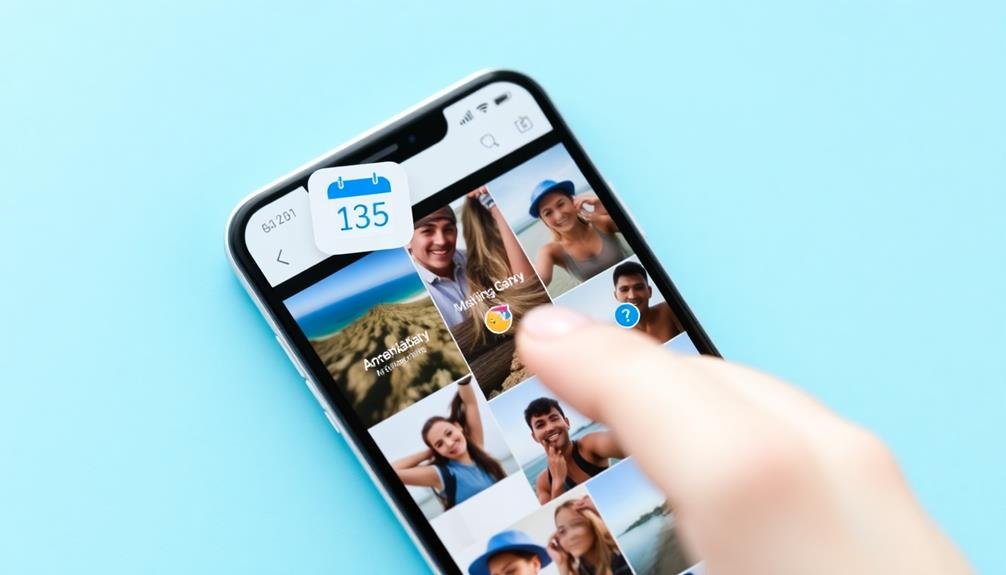
Delving into photo metadata reveals fundamental information about your mobile images. This hidden data includes details like the date and time the photo was taken, the device used, and even the location if geotagging is enabled. Understanding metadata is essential for efficient photo organization and sorting.
When you capture a picture on your smartphone, it automatically embeds this information into the image file. You can easily access this data through your phone's gallery app or by using specialized metadata viewing tools. Look for the EXIF (Exchangeable Image File Format) data, which contains the most relevant information for sorting.
The creation date is one of the most useful pieces of metadata for organizing your photos. It's typically stored in the "DateTimeOriginal" field. This timestamp allows you to sort your images chronologically, even if you've transferred them between devices or edited them later.
Be aware that some apps or social media platforms may strip or alter metadata when you share photos. To preserve this valuable information, always keep original copies of your images.
Understanding and utilizing photo metadata will greatly enhance your ability to manage and sort your mobile photo collection effectively.
Native Photo Apps Overview

Every smartphone comes equipped with a built-in photo app that serves as the central hub for managing your images. These native apps offer various features to help you organize, view, and edit your photos. While the specific functionalities may differ across platforms, most native photo apps provide similar core capabilities.
Regarding sorting photos by date, native apps typically excel at this task. They automatically organize your images chronologically, allowing you to browse through your collection with ease. You'll find options to view photos by day, month, or year, making it simple to locate specific memories.
Here's a quick comparison of popular native photo apps:
| Feature | iOS Photos | Google Photos | Samsung Gallery |
|---|---|---|---|
| Date sorting | Yes | Yes | Yes |
| AI categorization | Yes | Yes | Yes |
| Cloud backup | iCloud | Google Cloud | Samsung Cloud |
While these native apps are powerful, they may have limitations regarding advanced sorting or organizing options. If you need more robust features, you might consider third-party alternatives that offer additional functionality for managing your photo collection.
Third-Party Sorting Applications

For users seeking more advanced photo organization capabilities, third-party sorting applications offer a wealth of features beyond native apps. These apps provide powerful tools to efficiently sort and manage your mobile photo collection by date and other criteria.
Popular options like Google Photos and Amazon Photos use AI to automatically categorize your images, making it easy to find specific photos based on location, people, or objects. They also offer cloud storage, freeing up space on your device.
Apps like Slidebox and PhotoSort focus on quick manual sorting. You can swipe through images, assigning them to albums or deleting unwanted shots with simple gestures. This hands-on approach allows for more precise organization.
For professional photographers, apps like Adobe Lightroom Mobile and Mylio offer advanced cataloging features. These tools let you add metadata, create complex folder structures, and sync across multiple devices.
When choosing a third-party app, consider factors like storage limits, cross-platform compatibility, and privacy policies. Some apps offer free tiers with limited features, while others require subscriptions for full functionality.
Evaluate your needs and try out a few options to find the best fit for your photo organization style.
Cloud Storage Solutions

When it comes to organizing your mobile photos by date, cloud storage solutions offer powerful options.
Popular services like Google Photos, iCloud, and Dropbox provide automatic backup features that can sync and sort your images as you take them.
These platforms often boast cross-platform compatibility, allowing you to access and manage your date-sorted photos from various devices seamlessly.
Popular Cloud Storage Options
Cloud storage solutions have revolutionized the way we manage our digital photos. When it comes to popular options, you'll find several reliable services to choose from.
Google Photos stands out for its generous free storage and intelligent organization features. It automatically categorizes your images and offers powerful search capabilities.
Apple's iCloud is seamlessly integrated with iOS devices, making it a natural choice for iPhone users. It syncs your photos across all Apple devices and provides editing tools within the Photos app.
Dropbox, while not photo-specific, offers robust file management and easy sharing options. It's particularly useful if you're collaborating on photo projects.
Amazon Photos provides unlimited full-resolution photo storage for Prime members, making it an excellent value if you're already subscribed.
Microsoft OneDrive integrates well with Windows devices and Office applications, offering a familiar interface for PC users.
Flickr, popular among photographers, offers 1TB of free storage and a vibrant community for sharing and discovering images.
When choosing a cloud storage option, consider factors like storage capacity, pricing, device compatibility, and additional features that align with your photo management needs.
Automatic Photo Backup Features
One of the most valuable features offered by cloud storage solutions is automatic photo backup. This feature guarantees that your precious memories are safely stored in the cloud as soon as you take a picture. You won't have to worry about losing photos if your device is damaged, lost, or stolen.
Most cloud storage providers offer automatic backup options that you can easily configure on your mobile device. Once set up, your photos will be uploaded to the cloud whenever you're connected to Wi-Fi or cellular data, depending on your preferences.
To visualize how automatic photo backup works, imagine:
- You snap a photo of a breathtaking sunset
- Your phone quietly connects to the internet
- The image is instantly uploaded to your cloud storage
- A backup copy is now safely stored and accessible from any device
This seamless process happens in the background, requiring no effort on your part. You can customize settings like upload quality, frequency, and whether to use cellular data.
Some providers even offer intelligent organization features, automatically sorting your photos by date, location, or content, making it easier to find specific images later.
Cross-Platform Compatibility Benefits
Imagine accessing your photos seamlessly across all your devices. Cross-platform compatibility in cloud storage solutions makes this a reality. You'll benefit from the ability to view, edit, and organize your photos on any device, regardless of its operating system.
When you use a cloud-based photo storage service, you're no longer limited to a single platform. Whether you're using an iPhone, Android smartphone, Windows PC, or Mac, you can access your entire photo library with ease. This flexibility allows you to start sorting photos on your phone and continue on your laptop without missing a beat.
Cloud storage solutions also offer consistent user interfaces across platforms, reducing the learning curve when switching devices. You'll find familiar tools and features, making photo management effortless no matter which device you're using.
Additionally, cross-platform compatibility guarantees that your photos are always in sync. Any changes you make on one device will automatically reflect on all others, eliminating the need for manual updates or transfers. This synchronization feature saves time and prevents confusion caused by multiple versions of the same photo collection.
Automated Date-Based Sorting Methods
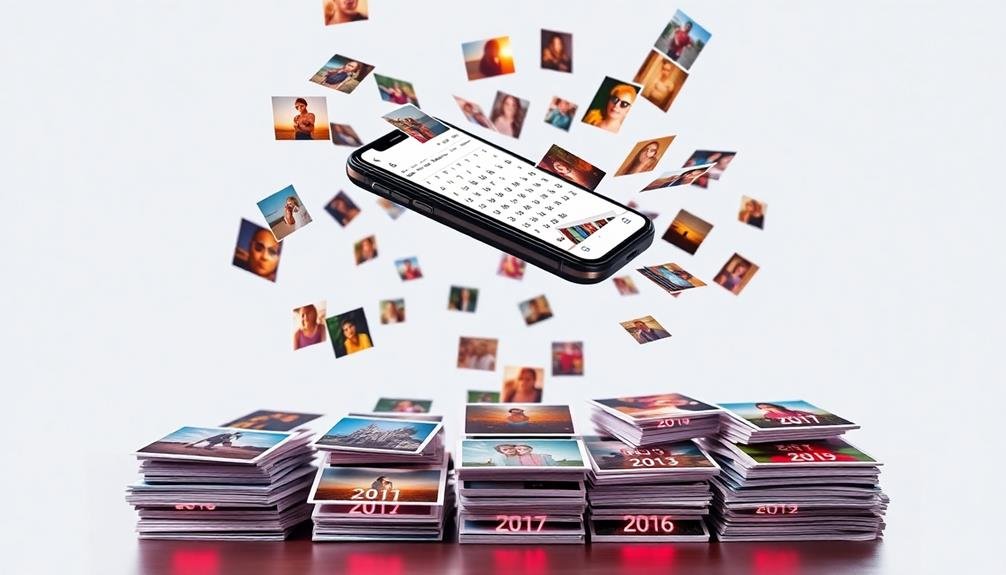
You'll find automated date-based sorting methods invaluable for organizing your mobile photos efficiently.
Cloud storage solutions often offer built-in features to automatically sort your images by date, making it easy to browse through your memories chronologically.
If your preferred cloud service lacks this functionality, you can turn to third-party sorting apps that specialize in arranging your photo library based on timestamps and other metadata.
Cloud Storage Solutions
Cloud storage solutions have revolutionized the way we manage our mobile photos, offering automated date-based sorting methods that take the hassle out of organizing your digital memories. Services like Google Photos, iCloud, and Dropbox provide seamless integration with your mobile devices, automatically uploading and categorizing your images by date and location.
When you use cloud storage for photo management, you'll experience:
- Instant organization: Your photos are sorted chronologically as soon as they're uploaded.
- Easy access: View your images from any device, anytime, anywhere.
- Smart search: Find specific photos using date ranges, locations, or even facial recognition.
- Automatic backup: Never worry about losing precious memories due to device failure or loss.
These platforms often include additional features like AI-powered tagging, creating albums based on events or trips, and suggesting edits or collages.
You can easily share entire albums or individual photos with friends and family, maintaining control over who sees what.
Third-Party Sorting Apps
While cloud storage solutions offer excellent built-in sorting capabilities, third-party sorting apps provide even more advanced options for organizing your mobile photos by date. These apps can automatically sort your photos into folders based on various date formats, such as year, month, or even specific events.
One popular app is "PhotoSort," which uses AI to analyze your photos' metadata and sort them accordingly. It can create custom albums for holidays, vacations, or special occasions.
Another option is "DateOrganizer," which allows you to set custom rules for sorting, such as grouping photos taken within a specific date range.
"TimeLine" is a unique app that creates a visual timeline of your photos, making it easy to browse through your memories chronologically.
For those who prefer a more hands-on approach, "ManualSort" lets you quickly swipe and categorize photos into date-based folders.
When choosing a third-party sorting app, consider factors like user interface, sorting speed, and compatibility with your device's operating system. Many apps offer free trials, so you can test them before committing.
With these tools, you'll have your photo collection neatly organized in no time.
Manual Date Organization Techniques

Despite the convenience of automatic sorting, manual date organization techniques can offer greater control over your photo collection. You'll find these methods particularly useful when dealing with images that have incorrect or missing metadata.
To manually organize your photos by date, start by creating folders for different time periods. You might use years, months, or even specific events as your organizational structure.
Once you've set up your folder system, you can begin sorting your photos. Here's a quick process to follow:
- Open each photo and check its details for the correct date.
- Rename the file to include the date in a consistent format (e.g., YYYY-MM-DD_filename).
- Move the photo to the appropriate folder based on its date.
- Add tags or descriptions to make future searches easier.
This method allows you to correct any dating errors and guarantee your photos are exactly where you want them.
While it's more time-consuming than automatic sorting, it provides unparalleled accuracy and customization. You'll have the satisfaction of knowing your photo collection is organized precisely how you prefer, making it easier to find and relive your cherished memories.
Batch Renaming Strategies

Streamline your photo organization process with batch renaming strategies. These techniques allow you to quickly rename multiple photos at once, saving time and guaranteeing consistency in your file naming system.
Start by selecting a group of photos you want to rename. Most operating systems and photo management software offer batch renaming features. Choose a naming convention that includes the date, such as "YYYY-MM-DD_PhotoDescription." This format guarantees your photos will sort chronologically when viewed in file explorer.
Use placeholders or variables in your renaming pattern to automatically include metadata like the original file name, capture date, or camera model. For example, you might use "{Date}__{FileName}" to preserve the original file name while adding the date prefix.
Consider incorporating sequential numbering in your batch rename to differentiate photos taken on the same day. A pattern like "YYYY-MM-DD_{SeqNum}_Description" can help maintain order.
For more advanced users, explore third-party batch renaming tools that offer additional features like regex support, EXIF data extraction, and custom scripting options. These tools can handle complex renaming scenarios and automate your workflow further.
Creating Custom Date Folders

Creating custom date folders is another powerful method to organize your mobile photos chronologically. This approach allows you to sort your images into specific directories based on when they were taken, making it easier to locate and manage your photo collection.
To implement this strategy, you'll need to create a folder structure that reflects your desired date format, such as year/month/day or year/month.
Once you've established your folder hierarchy, you can begin sorting your photos into the appropriate directories. Here's a simple process to follow:
- Review your photo's metadata to determine its capture date
- Create the necessary folders if they don't already exist
- Move the photo into the corresponding date folder
- Repeat for each image in your collection
You can automate this process using various software tools or scripts designed for photo organization. These tools can scan your entire photo library, extract date information, and automatically sort your images into the appropriate folders.
Syncing Across Multiple Devices

When sorting photos across multiple devices, you'll want to contemplate cloud storage solutions for seamless access.
Look for options that offer cross-platform compatibility, ensuring your photos are accessible from all your devices regardless of operating system.
Set up automatic sync settings to keep your photo organization consistent and up-to-date across your smartphone, tablet, and computer.
Cloud Storage Solutions
Cloud storage solutions offer a seamless way to sync and sort your mobile photos across multiple devices. Services like Google Photos, iCloud, and Dropbox automatically upload your images to the cloud, making them accessible from any device with an internet connection.
These platforms often include built-in sorting features, allowing you to organize your photos by date, location, or even facial recognition.
When choosing a cloud storage solution, consider:
- Storage capacity: Confirm you have enough space for your growing photo collection
- Automatic upload: Look for services that back up your photos as soon as you take them
- Cross-platform compatibility: Choose a solution that works with all your devices
- Sharing capabilities: Opt for a service that makes it easy to share albums with friends and family
To make the most of cloud storage, enable automatic backups on your mobile devices and set up sync across your computers. This confirms your photos are always up-to-date and accessible, regardless of which device you're using.
Many cloud services also offer advanced search features, making it easy to find specific photos based on date, location, or content.
Cross-Platform Compatibility
In light of the increasing number of devices we use daily, cross-platform compatibility has become vital for effective photo management. When you're sorting mobile photos by date, you'll want to make sure that your chosen method works seamlessly across all your devices. This includes smartphones, tablets, laptops, and desktop computers, regardless of their operating systems.
Look for photo management apps that offer native applications for iOS, Android, Windows, and macOS. These apps should sync your photo library and maintain your sorting preferences across all platforms. Pay attention to features like automatic background syncing and the ability to access your entire library from any device.
Consider using cloud-based solutions that offer web interfaces in addition to native apps. This approach allows you to sort and manage your photos from any device with a web browser. Make certain that the service you choose supports the file formats and metadata of your photos across different platforms.
When selecting a cross-platform solution, verify that it maintains the original capture dates and other important metadata during syncing and sorting processes. This consistency is essential for preserving the chronological order of your photo collection across all your devices.
Automatic Sync Settings
To guarantee your photos stay organized across all your devices, it's crucial to set up automatic sync settings. Most modern smartphones and cloud storage services offer this feature, allowing you to seamlessly keep your photo collection up-to-date everywhere.
Start by enabling automatic sync on your primary device, then follow the same process on your other devices.
When setting up automatic sync, consider these key factors:
- Storage capacity: Verify you have enough cloud storage to accommodate your entire photo library.
- Network usage: Choose whether to sync only over Wi-Fi or allow cellular data syncing as well.
- Battery consumption: Decide if you want syncing to occur only when your device is charging or anytime.
- Frequency: Set how often you want your devices to check for new photos to sync.
Dealing With Incorrect Date Stamps

Incorrect date stamps can throw a wrench into your photo organization efforts. These inaccuracies often occur when your device's time settings are off or when you've imported photos from various sources.
To fix this issue, you'll need to manually edit the metadata of affected images. On your smartphone, use a photo editing app that allows you to modify EXIF data. Look for options like "Edit Date" or "Change Timestamp" within the app.
For bulk edits on your computer, consider using specialized software like ExifTool or Adobe Bridge. If you're dealing with scanned photos or images without embedded dates, you can add this information yourself.
Most photo management software lets you input dates manually or in batches. When possible, estimate the date based on visual cues in the photo or your personal recollection.
For future uploads, verify your device's time and date settings are correct. This simple step can prevent most timestamp issues.
If you're importing photos from other devices or cameras, double-check their date settings before transferring files to avoid propagating incorrect timestamps across your collection.
Preserving Original Capture Dates
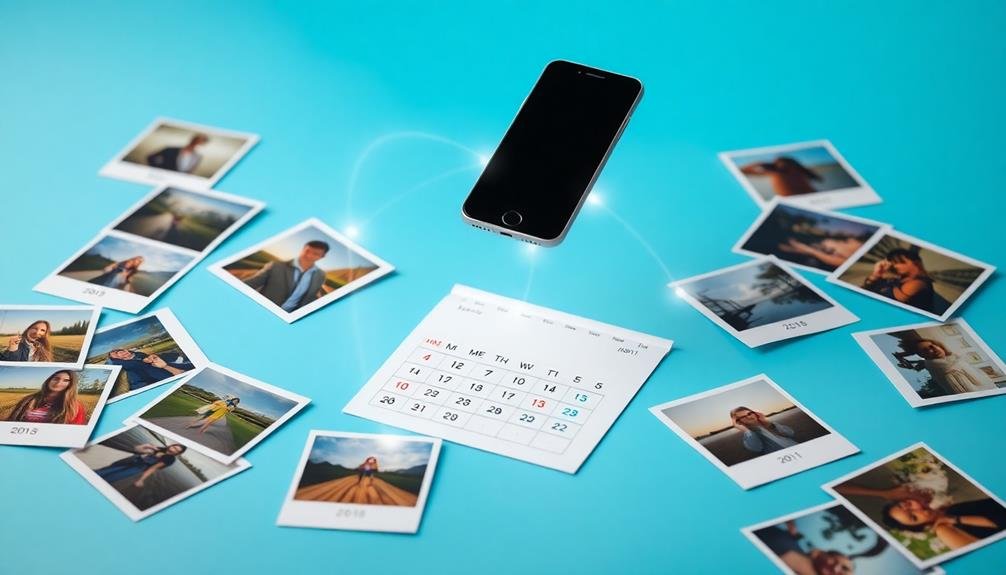
When organizing your mobile photos, it's essential to preserve the original capture dates.
You'll want to employ metadata retention techniques to guarantee that the date information remains intact throughout the sorting process.
Be cautious to avoid accidental date changes, as these can disrupt your photo timeline and make future organization more challenging.
Metadata Retention Techniques
Preserving the original capture dates of your mobile photos is vital for accurate sorting and organization.
To guarantee your photos retain their metadata, including capture dates, you'll need to employ specific techniques during transfer and storage processes.
When transferring photos from your mobile device to a computer or cloud storage, always use methods that maintain metadata integrity.
Avoid screenshot captures or image editing apps that might strip away important information. Instead, opt for direct file transfers or cloud syncing services that prioritize metadata retention.
To create a robust metadata retention strategy, consider these key steps:
- Use dedicated photo transfer apps that guarantee metadata preservation
- Enable automatic cloud backups with services that respect file attributes
- Regularly check transferred photos for intact metadata using file properties
- Avoid renaming files or modifying creation dates manually
Avoiding Accidental Date Changes
While retaining metadata is key, it's equally important to safeguard your photos' original capture dates from accidental changes. To prevent unintended modifications, disable any auto-sync features on your device that might alter timestamps.
When transferring photos between devices, use methods that maintain original metadata, such as AirDrop for iOS or dedicated photo transfer apps.
Be cautious when editing photos, as some apps may inadvertently update the creation date. Choose editing software that respects original metadata or offers options to preserve it. If you must adjust dates, create duplicates of your photos first to keep the originals intact.
Regularly back up your photo library to a secure location, ensuring you have a copy with original timestamps. When importing photos to your computer, double-check import settings to avoid overwriting existing date information.
If you're restoring photos from a backup or moving them to a new device, verify that the file transfer method you're using maintains original capture dates.
Sorting by Date Ranges
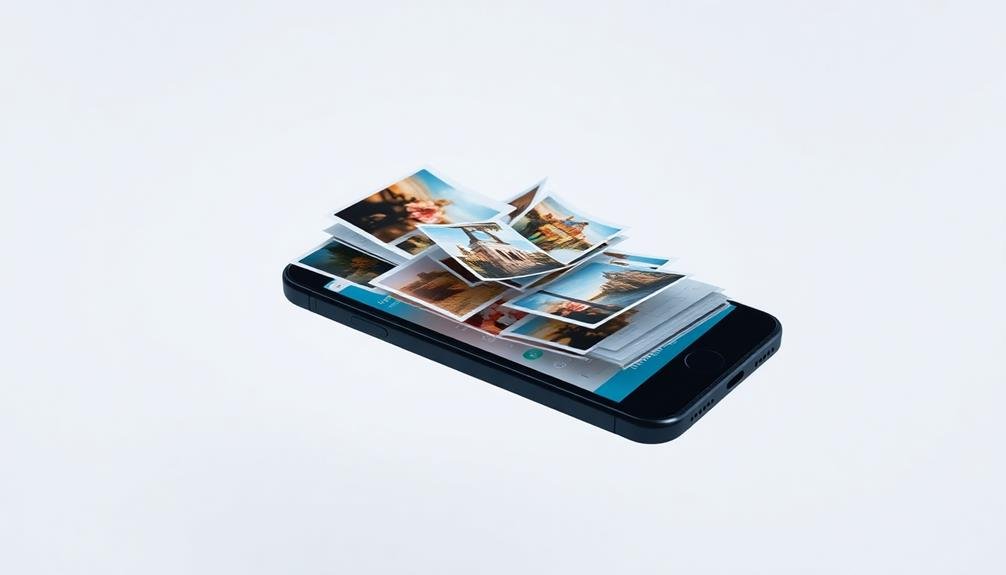
Many photo management apps offer the option to sort images by specific date ranges, giving users more control over their photo organization.
You'll find this feature particularly useful when you're looking for photos from a specific event or time period. To use date range sorting effectively, first decide on the timeframe you want to focus on. This could be a particular month, season, or even a custom range spanning multiple years.
Once you've determined your date range, follow these steps to sort your photos:
- Open your photo app and navigate to the search or filter options
- Look for a "Date" or "Timeline" filter
- Select the start and end dates for your desired range
- Apply the filter to view only photos from that period
Exporting Sorted Photos

Once you've sorted your photos by date, you'll often want to export them for various purposes. Most mobile photo apps offer straightforward export options. Look for a "Share" or "Export" button, usually represented by an icon with an arrow pointing outward.
When exporting, you'll typically have several choices. You can send photos directly to another app, such as email or messaging services. Alternatively, you might opt to save them to your device's storage or upload them to cloud services like Google Drive or Dropbox.
Many apps allow you to select multiple photos for bulk export. This is particularly useful when you've sorted photos into specific date ranges and want to export entire groups at once.
Pay attention to export quality settings; higher quality exports will take up more storage space but preserve image details.
If you're exporting to share with others, consider creating a compressed album or lowering the resolution to make file sizes more manageable. Some apps offer options to remove metadata, which can be important for privacy.
Remember to check your export destination's storage capacity before initiating large transfers to avoid running out of space.
Maintaining Organized Photo Libraries

After sorting and exporting your photos, the next challenge is keeping your photo library organized. Maintaining an organized photo collection requires consistent effort, but it'll save you time and frustration in the long run.
Establish a routine for importing and categorizing new photos as soon as you take them. Use descriptive file names and folders to make searching easier.
To maintain your organized photo library, follow these steps:
- Regularly back up your photos to a cloud service or external hard drive.
- Delete duplicate or unwanted images to free up space.
- Use tags or keywords to categorize photos by event, location, or people.
- Create albums for special occasions or themed collections.
Consider using photo management software to streamline your organization process. These tools often offer features like facial recognition, automatic tagging, and easy sharing options.
Set aside time each month to review and organize your recent photos, ensuring they're properly sorted and labeled.
Frequently Asked Questions
Can I Sort Photos by Date Without Using Any Apps or Software?
Yes, you can sort photos by date without apps or software. Your device's built-in photo gallery usually offers this option. Simply open your gallery, look for a "Sort" or "Organize" feature, and select "Date" as the sorting criteria.
How Do I Sort Photos Taken on Different Devices With Varying Time Zones?
To sort photos from different devices and time zones, you'll need to standardize timestamps. Adjust your devices' time settings to a single time zone or use photo management software that can recognize and reconcile time zone differences automatically.
Is It Possible to Sort Screenshots and Downloaded Images by Creation Date?
Yes, you can sort screenshots and downloaded images by creation date. Most devices and photo management apps automatically record this information. You'll find options to sort by date created in your gallery or file explorer settings.
Can I Automatically Delete Duplicate Photos While Sorting by Date?
Yes, you can automatically delete duplicate photos while sorting by date. Many photo management apps offer this feature. You'll need to enable the duplicate detection option before sorting. It'll save storage space and keep your gallery organized.
How Can I Recover the Original Date Information for Edited or Filtered Photos?
You can recover original date information for edited photos by checking the EXIF data. Use photo management software or apps that preserve metadata. If that's not available, search your device's backup or cloud storage for the original, unedited version.
In Summary
You've now learned various methods to effortlessly sort your mobile photos by date. Whether you're using native apps, third-party solutions, or cloud storage, you can easily organize your memories chronologically. Remember to preserve original capture dates and consider sorting by date ranges for better management. By exporting your sorted photos and maintaining an organized library, you'll always have quick access to your cherished moments. Keep these tips in mind, and you'll never struggle with photo chaos again.



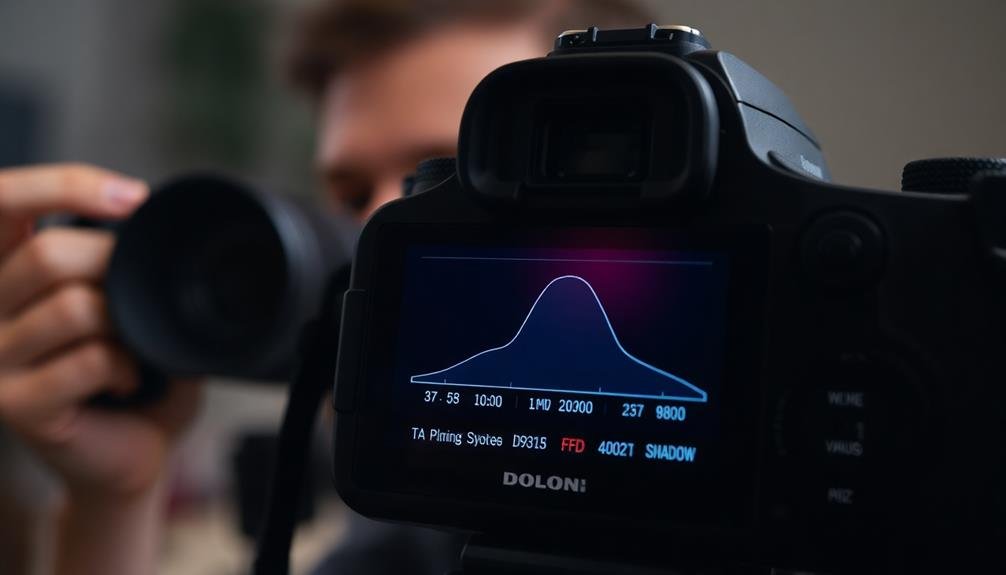
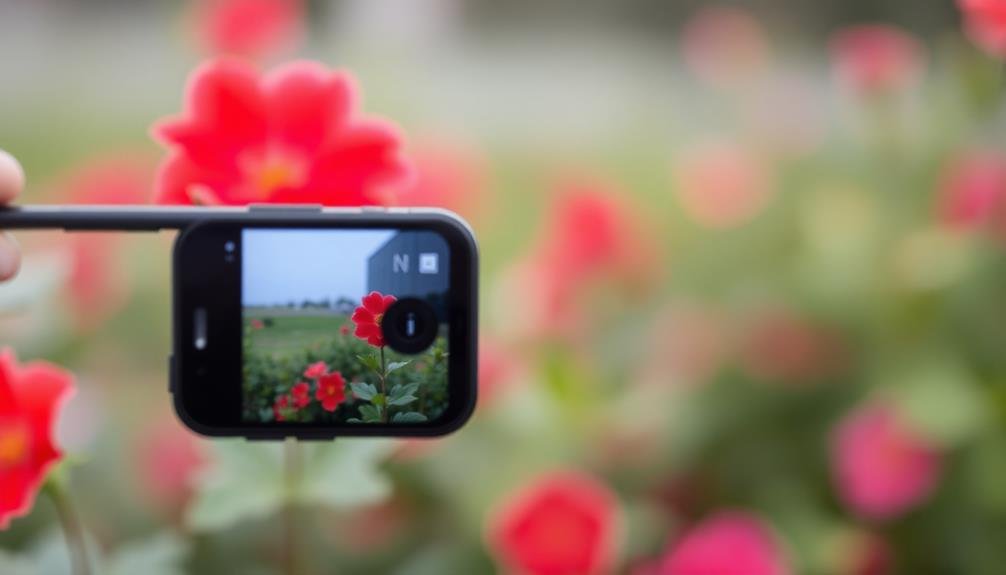
Leave a Reply